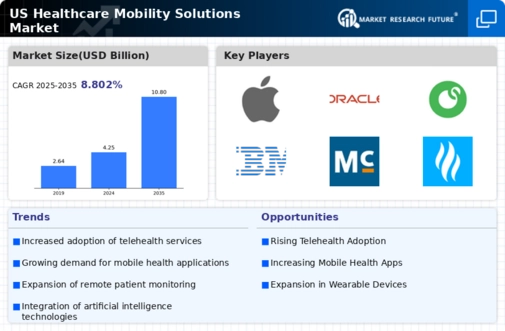Advancements in Mobile Health Applications
The healthcare mobility-solutions market is being propelled by rapid advancements in mobile health (mHealth) applications. These applications facilitate a wide range of healthcare services, including appointment scheduling, medication reminders, and health tracking. The increasing penetration of smartphones, with over 80% of the US population owning one, has created a fertile ground for mHealth solutions. Furthermore, the market for mHealth applications is projected to reach approximately $100 billion by 2025, reflecting a compound annual growth rate (CAGR) of around 30%. This growth is attributed to the rising consumer demand for convenient and accessible healthcare services. As mHealth applications continue to evolve, they are likely to play a pivotal role in enhancing patient engagement and streamlining healthcare delivery, thereby driving the overall healthcare mobility-solutions market.
Rising Demand for Remote Patient Monitoring
The healthcare mobility-solutions market is experiencing a surge in demand for remote patient monitoring (RPM) systems. This trend is driven by the increasing prevalence of chronic diseases, which necessitate continuous health monitoring. According to recent data, approximately 60% of adults in the US have at least one chronic condition, leading to a heightened need for effective management solutions. RPM technologies enable healthcare providers to monitor patients' vital signs and health metrics in real-time, thereby improving patient outcomes and reducing hospital readmissions. The integration of mobile applications and devices into healthcare practices is expected to enhance patient engagement and adherence to treatment plans. As a result, the healthcare mobility-solutions market is likely to expand significantly, with projections indicating a growth rate of around 25% annually over the next few years.
Growing Focus on Patient-Centric Care Models
The healthcare mobility-solutions market aligns with the growing focus on patient-centric care models. Healthcare providers are recognizing the importance of involving patients in their own care processes, which is leading to the development of mobile solutions that empower patients to take charge of their health. This shift is reflected in the rising adoption of patient engagement tools, such as mobile apps that provide personalized health information and facilitate communication with healthcare professionals. Research indicates that patient engagement can lead to a 20% improvement in health outcomes, underscoring the value of these solutions. As healthcare organizations strive to enhance patient satisfaction and outcomes, the healthcare mobility-solutions market is likely to benefit from this trend, with an expected growth trajectory that aligns with the increasing emphasis on patient-centered care.
Government Initiatives Supporting Digital Health
Government initiatives aimed at promoting digital health solutions are significantly influencing the healthcare mobility-solutions market. Various federal and state programs are being implemented to encourage the adoption of telehealth and mobile health technologies. For instance, the Centers for Medicare & Medicaid Services (CMS) has expanded reimbursement policies for telehealth services, making it more financially viable for healthcare providers to offer these solutions. This policy shift is likely to enhance access to care for underserved populations, thereby driving the demand for healthcare mobility solutions. Additionally, funding opportunities for digital health startups are increasing, further stimulating innovation in the sector. As these initiatives continue to evolve, they are expected to create a favorable environment for the growth of the healthcare mobility-solutions market.
Integration of Artificial Intelligence in Healthcare
The integration of artificial intelligence (AI) technologies into the healthcare mobility-solutions market is a transformative driver. AI applications are being utilized to analyze vast amounts of health data, enabling predictive analytics and personalized treatment plans. This trend is particularly relevant in the context of mobile health solutions, where AI can enhance decision-making processes for healthcare providers. Recent studies suggest that AI could potentially reduce diagnostic errors by up to 30%, thereby improving patient safety and care quality. As healthcare organizations increasingly adopt AI-driven tools, the healthcare mobility-solutions market is expected to witness substantial growth. The anticipated market value for AI in healthcare is projected to exceed $36 billion by 2025, indicating a robust demand for innovative mobility solutions that leverage AI capabilities.
























Leave a Comment